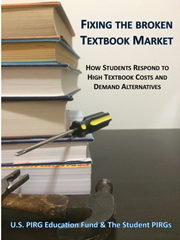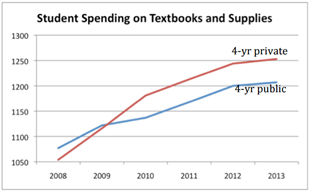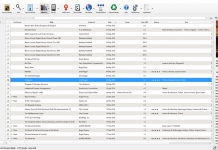 Mary Jarvis of Cornell University, a campus correspondent for USA Today, tells how college students are coping with outrageous textbook prices—sometimes with cameras or copying machines.
Mary Jarvis of Cornell University, a campus correspondent for USA Today, tells how college students are coping with outrageous textbook prices—sometimes with cameras or copying machines.
I’m delighted to see realistic articles like hers. Piracy of typical books isn’t common enough to justify DRM, as TOR and others have concluded. But textbooks can be a special case. What else can publishers expect from a “captive audience” forced to pay $1,200 a year on the average for books and supplies? Just one book may cost $200 or more. Read this 2014 report from public interest activists (PDF), source of the graph below.
Now put yourself in place of a typical cash-strapped student. What would you do? Sacrifice your education to help a conglomerate meet its quarterly goals for shareholders? I oppose piracy. But I certainly understand the “why.” Often textbook costs can even influence which courses students take.
In her article for USA Today’s campus edition, Ms. Jarvis tells how people are swapping PDFs, photocopying at the library or taking pictures, not just using social media to look for new or used bargains online. One of the students mentioned spends just $150 or so on books (a semester?). That’s overdone frugality. I want the better publishers to earn enough to stay in business. I’m pro-copyright even if the system is badly broken. When I call for well-stocked national digital libraries and a national digital library endowment, I regard fair compensation for creators as a major “must,” not a tiny detail.
Even so, one wonders why textbook prices have gone up 1,041 percent since January 1977, according to NBC News, working with government statistics. Yes, publishers have offered such responses as the fact that students can pay $200 a semester to rent e-textbooks from CourseSmart (assuming it carries the titles they need?). But on the whole, the excuses just won’t cut it.
A spokeswoman for the Association of American Publishers has talked about the “law of small numbers” and noted that a textbook going up from $50 to $100 would be counted as a 100 percent increase, still smaller than the thousands of dollars that a five percent rise in tuition could cost. Acknowledged. But those “small numbers” can add up to big numbers. If only payments to the actual authors had rocketed by 1,047 percent while textbook prices were doing so!
 Simply put, the U.S. copyright system is pro-corporation and pro-political contributor, not pro-writer. How to fix this?
Simply put, the U.S. copyright system is pro-corporation and pro-political contributor, not pro-writer. How to fix this?
In the case of textbooks, we might actually need laws suspending copyright protection for overpriced titles. Might. For now, I’d favor open source alternatives and price controls instead. Professors, not students, choose the textbooks, and here the so-called “market economy” has failed.
Textbook gouges have gotten so far out of hand that the headline in the USA Today campus edition reads: “How to fight back against budget-breaking textbook prices.” Think about it. A high percentages of the practices described in the piece are illegal under copyright law. And yet USA Today has positioned Ms. Jarvis’s piece as a “how-to.” A big mainstream newspaper publishing a piracy guide? No. Ms. Jarvis’s article does not say, “Go out and pirate,” and much and perhaps most of her article in effect provides legal coping tips such as buying used. Still, the “how to” headline should remind textbook publishers how far their priorities have diverged from those of society as a whole.
Meanwhile kudos to Ms. Jarvis and NBC and of course to the Student Public Interest Research Groups and the U.S. PIRG Education Fund. The PIRG groups were behind the study of textbook gouges. I hope that they, Ms. Jarvis and NBC will now go on to consider the need for a national digital digital library endowment and well-stocked libraries online, two goals of LibraryCity.org, a site I cofounded. U.S. public libraries can spend only about $4 per capital each year on books and other content.
Helpful, too, would be a major publicity campaign against Digital Rights Management and the resultant inability of book buyers to own their “protected” books legally for real. As a starting point, I recommend they read Let’s put power back in the hands of readers, by Linday Tessier, writing in the Guelph Mercury. While the paper is Canadian, the issues are universal. DRM is a global blight on booklovers. The best DRM for readers is none. If not, then we need compromises such as social DRM.


































David: A very good update on a problem that continues to plague students, professors, textbook authors, and, yes, textbook publishers. I’ve been tracking this issue for a long time and the one article I unequivocally recommend on the topic is Phil Hill’s “How Much Do College Students Actually Pay For Textbooks?” Phil pins down the pricing data better than any other source, offering balance and clarity. http://mfeldstein.com/how-much-do-college-students-actually-pay-for-textbooks/
@Thad: Nice hearing from you, and thanks so much for linking to Phil Hill’s work, which I read along with comments on it from other experts. The bottom line is that many industry observers question the appropriateness of the $1,200 figure.
Meanwhile, responding to him, activists acknowledge flaws in the statistic. But they point out the distinction between the price tags on the books and what students are actually spending. Some students just skip buying textbooks because they can’t afford them. Or if we can extrapolate from Mary Jarvis’s article, no small number are pirating. So that also skews the numbers for actual spending.
In the end, I’m reminded of unemployment figures—pushed downward by the fact that so many have stopped looking for work.
What’s more, activists also have pointed out that some measures to reduce costs, such as used books and rentals and international editions, can only go so far over the long run.
Needless to say, the above remarks are my take on the debate rather than Phil Hill’s.
Thanks again, Thad, for enriching the discussion with the link.
David
Amazon can be a student’s friend, both by dramatically reducing the cost to purchase books and by providing cheaper rentals. A text that rents from our local bookstore for $80 may rent from Amazon for $20.
Against that, publishers have ramped up anti-competitive practices. As a college prof., I get contacted nearly every semester by publisher reps telling me that my regular textbook might go out of print in a few months, but that they will gladly prepare a custom version for my course (which will cost the students more, be unavailable anywhere except our campus bookstore, and stamped with the year and semester to intimidate students thinking about buying used copies.)